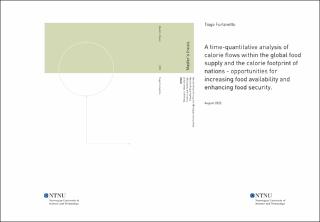| dc.contributor.advisor | Hertwich, Edgar. | |
| dc.contributor.advisor | Rasul, Kajwan. | |
| dc.contributor.author | Furlanetto, Tiago | |
| dc.date.accessioned | 2022-12-06T18:19:32Z | |
| dc.date.available | 2022-12-06T18:19:32Z | |
| dc.date.issued | 2022 | |
| dc.identifier | no.ntnu:inspera:110283387:69983951 | |
| dc.identifier.uri | https://hdl.handle.net/11250/3036215 | |
| dc.description.abstract | Motivert av interessen for å finne måter å øke tilgjengeligheten på mat for å mate befolkningen i 2050 samtidig som den møte den økende globale etterspørselen etter avlinger til andre formål, presenterer dette arbeidet en tidsmessig og kvantitativ analyse av den globale matforsyningen, hensyn til hvordan produksjonen av spiselige kalorier har blitt fordelt på ulike konkurransemessige bruksområder – mat, fôrdyr og ikke-mat. Kaloriallokering til ikke-mat-aktiviteter økte betydelig i løpet av studieperioden. Imidlertid ble det funnet at dyrerelaterte tap står for størstedelen av spiselige kaloritapet fra matsystemet. For å vurdere påvirkningen av dyrebasert matforbruk og kostholdspreferanser på dagens struktur i matsystemet, ble fem spisemønstre analysert - dagens mønster, EAT-Lancet, Middelhavet, Vegetarisk og Vegansk. Resultatet viser at bare betydelige endringer i forbruket av animalske produkter vil gjøre det mulig for dagens matsystem å mate de anslåtte 10 milliarder menneskene. Videre, mens man utførte den tidsmessige analysen av nasjonens fotavtrykk, ble det identifisert at det har vært en økning i land som er avhengige av import for å møte innenlandsk etterspørsel. Høyinntektsland med høyt forbruk av dyrebasert mat og utviklingsland, kjent for sin store og omfattende kjøtt- og meieriproduksjon, har en mengde kalorier innebygd i produktene sine som er opptil 5 ganger høyere enn deres endelige forbruk. Analysen viste at matsikkerhet og bærekraften til matsystemet er avhengig av endringer i avlingstildeling og en mer egalitær fordeling av verdensproduksjonen. | |
| dc.description.abstract | Motivated by the interest in finding ways to increase the availability of food in order to feed the population in 2050 while also meeting the growing global demand for crops for other purposes, the present work presents a temporal and quantitative analysis of the global food supply, taking into account how the production of edible calories has been allocated among different competitive uses – food, feed livestock and non-food. Calorie allocation to non-food activities increased significantly during the study period. However, it was found that animal-related losses account for the majority of edible calorie losses from the food system. Thus, in order to assess the influence of animal-based food consumption and dietary preferences on the current structure of the food system, five eating patterns were analysed - current pattern, EAT-Lancet, Mediterranean, Vegetarian and Vegan. The result shows that only substantial changes in the consumption of animal-based products will enable the current food system to feed the estimated 10 billion people. Furthermore, while performing the temporal analysis of the nation's footprint, it was identified that there has been an increase in countries reliant on imports to meet domestic demand. High-income countries with high consumption of animal-based food and developing countries, known for their large and extensive meat and dairy production, have an amount of calories embedded in their products that is up to 5 times higher than their final consumption. The analysis showed that food security and the sustainability of the food system are dependent on shifts in crop allocation and a more egalitarian distribution of world production. | |
| dc.language | eng | |
| dc.publisher | NTNU | |
| dc.title | A time-quantitative analysis of calorie flows within the global food supply and the calorie footprint of nations - opportunities for increasing food availability and enhancing food security. | |
| dc.type | Master thesis | |
